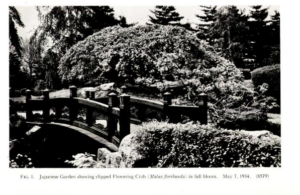By examining the constriction of access to and behavior within the Japanese garden, situated in the Brooklyn Botanic gardens, I argue that the Garden’s commissioners aimed to maintain Japanese ‘otherness’. By using an additional behavioral standard’s and enforcing a code of conduct deemed unnecessary across the rest of Brooklyn Botanic Gardens. By controlling how the Japanese garden was perceived and restricting how it was used by the public, the gardens’ commissioners established their authority over writing Japanese culture in an American context. 1 This article uses images, maps, manuals and entrance signs of Japanese parks in western foreign countries to illustrate that despite the absence of an enclosure garden as a consistent tradition in Japanese culture, in the west, Japanese gardens are enclosed and purposefully detached from the larger garden. The separation and containment of Japanese gardens in the West highlights the containment and fetishization of these spaces and also the use of isolation as a form of exerting power over the the translation of Japanese culture in Western public discourse.2

Figure 1: Image of the Flowing Crab in Japanese Garden from the Brooklyn Botanic Garden Record, 19343
Rather than being immersed in the surrounding context of a public park, the Japanese garden is frequently isolated and this practice is justified by marketing the Japanese garden as a superior garden and yet it perpetuates a hierarchical binary between ‘the west and the rest’.4 For the Japanese garden in Brooklyn Botanic Gardens, established in 1915 and designed by Takeo Shiota, restrictions over behavior and use of space have constrained it to become a disciplinarian space. the Boston Botanic Gardens enclose the Japanese garden with a wooden fence which is justified as an element of tradition, however, there a plethora of cases in Japan where this does not apply, and this wall was erected fifteen years after the Japanese garden was officially opened.5 The physicality of the separation between conceptions of Japanese horticulture in the eyes of American observers comparatively to its ‘authentic’ purpose within Japanese culture. Frequent financial support provided by the Japanese government to support the establishment of Japanese gardens in western cities highlights that whilst the Japanese government intended to enforce soft power through diplomatic advances like financial support to establish Japan within the vision of the American Garden-observer, commissioners who controlled public parks made significant spatial choices which limited the assimilation of Japanese tastes into American gardens by consistently organizing Japanese gardens as a traditional, formalized novelty.
Specific, traditional behavioral codes were enforced on entrance to the Brooklyn’s Japanese Garden which operated to restrict creativity and freedom of movement in the space. Signs around the garden advised visitors to ‘stroll’, there are no benches and it is stipulated that walking on the grass is prohibited.6 Similarly, children were to be accompanied at all times in fear that they would disrupt the tranquil atmosphere and case noise and disrupt the reflective atmosphere.7 The active performance of enjoyment due to the limited interaction allowed with the garden restricts it from becoming a “lived space” where people are able to create memorable interactions and explore freely. By exoticizing the Japanese Garden the gardens commissioners removed its capacity to integrate into Brooklyn’s spatial politics and local culture because it was associated with the foreign and unfamiliar behaviors and sensations enforced by the park itself.
The mystification of the components of the Japanese Garden and their contribution to its cultural significance in turn establish the authority of curating the general knowledge accessible to the American public regarding these spaces to the commissioner of the Botanic gardens. In the Brooklyn Botanic Garden Handbook on Japanese gardens from 1968, the Japanese garden sis described as illustrating, “the peculiar attitude of the Japanese towards life, in which they join nature with everyday living’.8 By presenting the Japanese ‘mentality’ as separate and therefore distant, foreign, exoticized and ultimately for consumption the language used in this handbook highlights how a powerful construction of knowledge through the containment of the Japanese garden as a phenomenon purposefully separated from the holistic botanic garden structure served to establish a binary in the American mind between western, familiar conceptions of the use and behavior within a park or garden and the ‘otherness’ of the Japanese garden. Indeed, the language used also served to describe ‘western’ and ‘eastern’ understandings of garden composition in opposition to each other, ‘the symmetry, uniformity and rectilinearity of Western gardens is disregarded in the Japanese garden’ .9 Resultantly, the western authorities prevailed in establishing control over the ‘otherness’ of the Japanese garden within the context of the public park. By dispensing mystified, vague and shifting details on the significance of the stones, lanterns and bridges present in the Japanese garden, the casual romantic exoticism of the ‘orient’ in American spatial politics prevailed.
To conclude, information and behaviors inscribed onto the Japanese garden by commissioners and local councils in an American context have served to fundamentally alter the conception of the Japanese garden and thus the curated image of Japan ‘mentality’ within the American observer. The interests of local authorities to present the Japanese garden as a concentrated impression of the ‘core qualities’ of an exoticized Japan conflicted with the assimilation of Japanese culture into the American observer that was desired by the Japanese government.
- Christian Tagsold, Spaces in Translation: Japanese Gardens and the West (Philadelphia, 2017), p.137. [↩]
- Tagsold, Spaces in Translation, p.138. [↩]
- Brooklyn Botanic Garden Record, (Brooklyn, 1934), p. 10 [↩]
- Tagsold, Spaces in Translation, p.137. [↩]
- Tagsold, Spaces in Translation, p.127. [↩]
- Brooklyn Botanic Garden and Kan Yashiroda, Handbook on Japanese Gardens and miniature Landscapes (Brooklyn, 1968), p.6. [↩]
- Tagsold, Spaces in Translation, p.130. [↩]
- Brooklyn Botanic Garden and Kan Yashiroda, Handbook on Japanese Gardens and miniature Landscapes (Brooklyn, 1968), p.6. [↩]
- Brooklyn Botanic Garden and Kan Yashiroda, Handbook on Japanese Gardens, p.9. [↩]